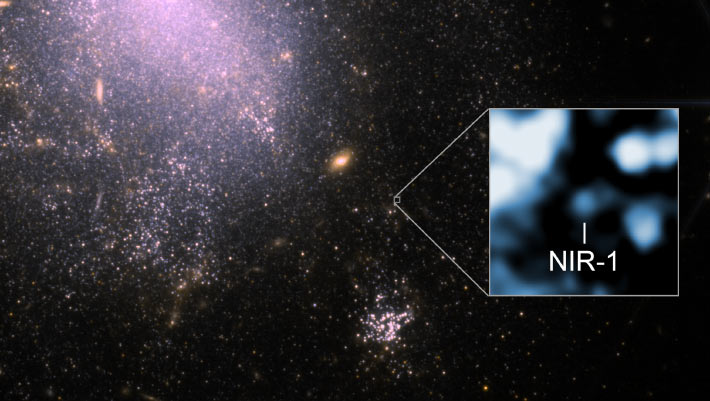Labeled FRB 20250316A and nicknamed RBFLOAT (Radio Brightest FLash Of All Time), the event occurred in the outer regions of the nearby spiral galaxy NGC 4141.
An infrared Webb image of the galaxy NGC 4141 containing the fast radio burst FRB 20250316A. Image credit: NASA / ESA / CSA / CfA / Blanchard et al. / P. Edmonds.
Fast radio bursts (FRBs) are brief and brilliant explosions of radio waves that originate mostly from extragalactic distances.
The first FRB was discovered in 2007, although it was actually observed some six years earlier, in archival data from a pulsar survey of the Magellanic Clouds.
These events have durations of milliseconds and exhibit the characteristic dispersion sweep of radio pulsars.
They emit as much energy in one millisecond as the Sun emits in 10,000 years, but the physical phenomenon that causes them is unknown.
Theories range from highly magnetized neutron stars, blasted by gas streams near to a supermassive black hole, to suggestions that the burst properties are consistent with signatures of technology developed by an advanced civilization.
The FRB 20250316A event was discovered on March 16, 2025, in NGC 4141, a barred spiral galaxy located about 130 million light-years away in the constellation of Ursa Major.
The detection was made with the CHIME Outriggers array, a radio telescope in Canada, which was recently upgraded to enable FRB detections with precise positions.
“With the CHIME Outriggers, we are finally catching these fleeting cosmic signals in the act — narrowing down their locations not only to individual galaxies, but even to specific stellar environments,” said Dr. Amanda Cook, a postdoctoral researcher at McGill University.
Dr. Cook and her colleagues then turned to the NASA/ESA/CSA James Webb Space Telescope to look for an infrared signal from the same location.
“This was a unique opportunity to quickly turn Webb’s powerful infrared eye on the location of an FRB for the first time,” said Dr. Peter Blanchard, an astronomer with the Harvard College Observatory at the Harvard & Smithsonian’s Center for Astrophysics.
“And we were rewarded with an exciting result — we see a faint source of infrared light very close to where the radio burst occurred.”
“This could be the first object linked to an FRB that anyone has found in another galaxy.”
The infrared data from Webb revealed an object, dubbed NIR-1, that is likely a red giant star or possibly a middle-aged massive star.
A red giant is a Sun-like star near the end of its life that has expanded and brightened, while the other possibility is a star much more massive than the Sun.
Although these stars are unlikely to directly produce FRBs, they may have an unseen companion, such as a neutron star, pulling material away from the red giant or massive star. This process of transferring mass may have triggered the FRB.
The advantages of its relatively close proximity and precise location, combined with the sharp Webb images, allowed the clearest view of individual stars ever seen around an FRB’s location.
“Dozens of different ideas have been proposed to explain FRBs, but until now we haven’t had the data to test most of them,” said Professor Edo Berger, an astronomer at the Harvard & Smithsonian’s Center for Astrophysics.
“Being able to isolate individual stars around an FRB is a huge gain over previous searches, and it begins to tell us what sort of stellar systems could produce these powerful bursts.”
The red giant or massive star could, however, be unrelated to the FRB, which motivated the researchers to study its larger environment for any additional clues.
They found the FRB is located near a small cluster of young massive stars.
Based on this location, they suggested that a massive star in the cluster may have already collapsed to form a magnetar, which produced the FRB.
A magnetar would be much too faint to be directly seen in the Webb data.
The team considered several other possible explanations for the FRB, including an object in a dense cluster of old stars, or a massive giant star.
These would be brighter than the faint star they observed, so these explanations were ruled out.
“Whether or not the association with the star is real, we’ve learned a lot about the burst’s origin,” Dr. Blanchard said.
“If a double star system isn’t the answer, our work hints that an isolated magnetar caused the FRB.”
Another possible explanation for the infrared signal is that it is reflected light caused by a flare from the object that caused the radio burst, such as from a magnetar. If so, the infrared light is likely to fade over time.
The team will propose more Webb observations to search for such a change.
“We have taken the first step on a new path to solving the mystery of FRBs using the sharp imaging of Webb to zoom in on the precise locations from which FRBs are emanating,” Professor Berger said.
“We can’t predict when and where the next FRB will come from, so we have to be ready to quickly deploy Webb when the time comes.”
The team’s paper was published in the Astrophysical Journal Letters.
_____
Peter K. Blanchard et al. 2025. James Webb Space Telescope Observations of the Nearby and Precisely Localized FRB 20250316A: A Potential Near-IR Counterpart and Implications for the Progenitors of Fast Radio Bursts. ApJL 989, L49; doi: 10.3847/2041-8213/adf29f
